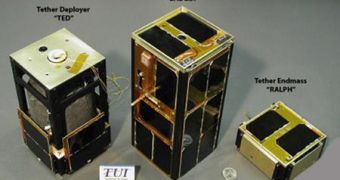Rob Hoyt, chief executive officer of Tethers Unlimited of Bothell, Washington, US, and his team are gearing up to launch a mission to study just how a tether and spacecraft move together in space.
A tether is a ropelike restraint, 1-kilometer-long, used as a safety measure planned to be used in space, on which a thermos-flask-sized satellite will ride up and down, like a skier in a gondola lift, set to launch on 17 April.
Designed to test technologies that could be used to boost future satellites into higher orbits, the tether mission should be visible with binoculars - and possibly the naked eye.
Researchers believe that long tethers, rotating lengthwise, could one day catch satellites in space and fling them to higher orbits. This could allow rockets to use less fuel if they launched satellites to relatively low altitudes before having the tether take over, boosting the satellites into higher orbits - or out of Earth's orbit altogether
The mission is comprised of three "picosatellites" which together take up the volume of a loaf of bread. Seven days after they reach their orbit, at an altitude of 750 kilometres, the satellites will separate, pulling a 1-kilometre-long tether taut as they do.
Two satellites will act as anchors for the ends of the tether, while the middle satellite - the "inspector", called Gadget - will travel back and forth along its length, using a digital camera to scan for damage from micrometeoroids, space junk, radiation and corrosive atomic oxygen.
Gadget will use solar panels to power its crawl - a trip that takes seven days from one end of the tether to the other. Its motor is expected to last at least three months, providing continuous updates on the health of the tether over time.
The researches hope to get a better idea of the risks future space tethers will face, since the first one, 20-kilometer-long, launched in 1994, broke after just five days, probably because it hit a micrometeorite.
All three satellites will be fitted with Global Positioning System (GPS) devices so researchers will be able to study whether the tether wiggles and the satellites stay in their desired configuration.
All amateur astronomers should prepare their instruments from 17 April, because "We expect it to be visible under the right conditions from the ground, with telescopes, binoculars, and possibly the naked eye," said Hoyt.

 14 DAY TRIAL //
14 DAY TRIAL //